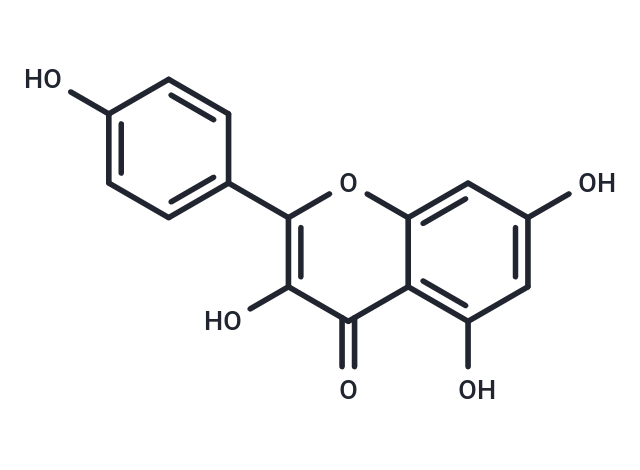Shopping Cart
Remove All Your shopping cart is currently empty
Your shopping cart is currently empty
Kaempferol (Robigenin) is a natural flavonoid and an inverse agonist of ERRα and ERRγ. Kaempferol has a wide range of antitumor, anti-inflammatory, antioxidant, antibacterial and antiviral activities.

| Pack Size | Price | USA Warehouse | Global Warehouse | Quantity |
|---|---|---|---|---|
| 25 mg | $33 | In Stock | In Stock | |
| 50 mg | $46 | In Stock | In Stock | |
| 100 mg | $58 | In Stock | In Stock | |
| 500 mg | $197 | In Stock | In Stock | |
| 1 g | $289 | In Stock | In Stock | |
| 1 mL x 10 mM (in DMSO) | $50 | In Stock | In Stock |
| Description | Kaempferol (Robigenin) is a natural flavonoid and an inverse agonist of ERRα and ERRγ. Kaempferol has a wide range of antitumor, anti-inflammatory, antioxidant, antibacterial and antiviral activities. |
| Targets&IC50 | HMGB1:28.9 μM (Kd), NO release:5.02 μM (RAW264.7 cells), Antiamoebic activity (against N. fowleri trophozoites):29.28 ± 0.63 μM |
| In vitro | METHODS: Human breast cancer cells MDA-MB-231 were treated with Kaempferol (0.01-100 μM) for 72 h, and cell viability was detected by MST assay. RESULTS: Kaempferol inhibited cell proliferation in a dose-dependent manner with an IC50 value of 43 μmol/L. [1] METHODS: Human gastric cancer cells AGS and SNU638 were treated with Kaempferol (50 μM) for 8-24 h. The expression levels of target proteins were detected by Western Blot. RESULTS: Kaempferol increased cleaved caspase-3 and -9 and decreased Bcl-2 levels in a time-dependent manner. [2] |
| In vivo | METHODS: To investigate the effects on hemorrhagic shock mice, Kaempferol (10 mg/kg) was administered intraperitoneally to C57/BL6 mice experiencing hemorrhagic shock. RESULTS: Pre-treatment of hemorrhagic shock mice with Kaempferol significantly reduced plasma TNF-α and IL-6 levels; restored MPO, SOD and MDA in the heart, lungs and liver; and increased HO-1 expression in the same organs. [3] METHODS: To study the anti-neuroinflammatory effects, Kaempferol (25-100 mg/kg) was administered by gavage to BALB/c mice once a day for seven days, and LPS (5 mg/kg) was injected on the seventh day. RESULTS: Kaempferol may be a promising neuroprotective agent to alleviate inflammatory responses and blood-brain barrier dysfunction by inhibiting HMGB1 release and downregulating the TLR4/MyD88 inflammatory pathway. [4] |
| Kinase Assay | Right atria or sinus nodal cells are homogenized in lysis buffer consisting of (50 mM Tris-HCl pH 7.5, 100 mM KCl, 1 mM ethylenediamine tetraacetic acid, 1 mM ethylene glycol tetraacetic acid, 1 mM dithiothreitol, 0.1 mM phenylmethylsulfonyl fluoride, 0.5 mM Benzamidine, 20 mg/L Leupeptin, 20 mM sodium pyrophosphate, 50 mM NaF, and 50 mM sodium β-glycerophosphate), and total protein content is determined by the Bradford assay. Caspase-3 activity is determined by EnzChek Caspase-3 Assay Kit[3]. |
| Cell Research | Kaempferol is prepared in DMSO (100 mM) and stored (-20°C), and then diluted with appropriate medium[2]. Ovarian cancer cells are seeded in 96-well plates at 2000 cells/well and incubated overnight before treatment with 0-160 μM Kaempferol for 24 hours in triplicates. The medium is removed, and the plates are freeze-thawed to lyse cells. Each well is added with 200 μL 1× CyQUANT cell lysis buffer containing 5x SYBR Green I and incubated at room temperature (RT) for 5 minutes. The reaction (50 μL) is transferred to PCR strip tubes and the fluorescent signal is measured at 90°C with a real-time Chromo4 PCR instrument. To ensure that cell proliferation assays are performed within a linear range of cell numbers, a standard curve is generated by seeding different amount of OVCAR-3 cells (based on counting with a hemacytometer) in a 96-well plate, and measuring genomic DNA abundance after overnight incubation. Three independent experiments are performed and data is pooled for statistical analysis[2]. |
| Synonyms | Robigenin, Kempferol |
| Molecular Weight | 286.24 |
| Formula | C15H10O6 |
| Cas No. | 520-18-3 |
| Smiles | O=C1C=2C(OC(=C1O)C3=CC=C(O)C=C3)=CC(O)=CC2O |
| Relative Density. | 1.688 g/cm3 |
| Color | Yellow |
| Appearance | Solid |
| Storage | Powder: -20°C for 3 years | In solvent: -80°C for 1 year | Shipping with blue ice/Shipping at ambient temperature. | ||||||||||||||||||||||||||||||||||||||||
| Solubility Information | H2O: < 1 mg/mL (insoluble or slightly soluble) Ethanol: 28.6 mg/mL (99.92 mM), Sonication is recommended. DMSO: 45 mg/mL (157.21 mM), Sonication is recommended. | ||||||||||||||||||||||||||||||||||||||||
| In Vivo Formulation | 10% DMSO+40% PEG300+5% Tween 80+45% Saline: 2.87 mg/mL (10.03 mM), Solution. Please add the solvents sequentially, clarifying the solution as much as possible before adding the next one. Dissolve by heating and/or sonication if necessary. Working solution is recommended to be prepared and used immediately. The formulation provided above is for reference purposes only. In vivo formulations may vary and should be modified based on specific experimental conditions. | ||||||||||||||||||||||||||||||||||||||||
Solution Preparation Table | |||||||||||||||||||||||||||||||||||||||||
Ethanol/DMSO
DMSO
| |||||||||||||||||||||||||||||||||||||||||
| Size | Quantity | Unit Price | Amount | Operation |
|---|

Copyright © 2015-2025 TargetMol Chemicals Inc. All Rights Reserved.